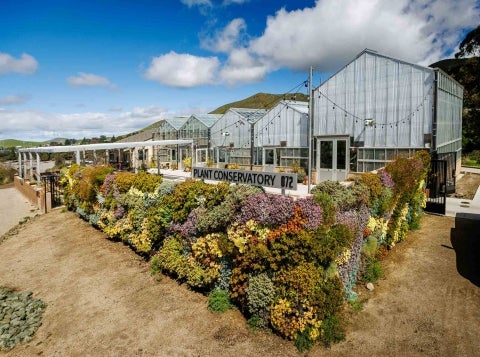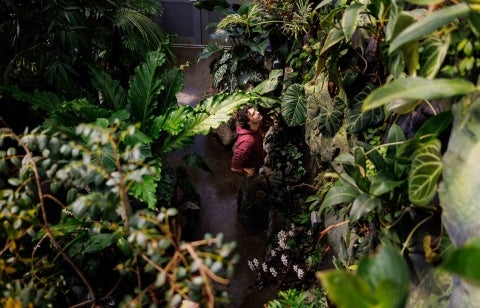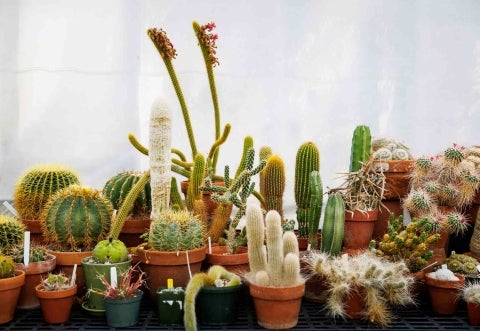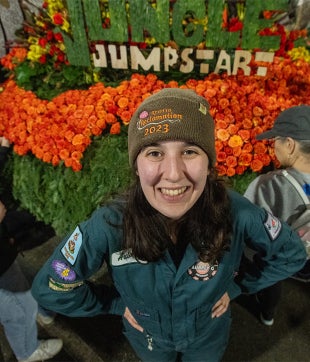Cal Poly’s New Plant Conservatory with Biodiverse Species Officially Opens
Contact: Nick Wilson
805-235-8008, nwilso28@calpoly.edu
The conservatory features greenhouses that accommodate extreme climate conditions, research labs and office space

Photo by Cal Poly university photographer Joe Johnston
SAN LUIS OBISPO — The new Cal Poly Plant Conservatory — a $5 million, 5,000 square-foot, multi-use botanical science facility with greenhouses, labs and offices — has opened for operation this year.
Featuring living plants that grow in extreme weather conditions, including exotic and rare species, the conservatory’s greenhouses showcase three distinct growing environments: the warm tropics; a cloud forest; and desert climate. In addition, there is dedicated space for experimental research for urban planning.
The facility has 2,500 square feet under greenhouse glass and an equal amount of outdoor space. The varied plant collection includes cacao, mahogany, banana, several types of cacti and koa — one of the most valuable hardwoods in the world, a species (acacia koa) that only grows on the Hawaiian Islands.

Photo by Cal Poly university photographer Joe Johnston
“We have a great diversity of plants, including some species that you’d have to travel far and wide to find,” said Matt Ritter, the plant conservator director, a biological sciences professor and noted national tree expert. “It’s an impressive learning experience with such a wide range of flora right here on campus, and it’s very exciting to be studying strategies toward adding more foliage to the world.”
As urban planning calls for planting more tree for shade and to sequester carbon in wood, plant matter and the soil amid rising global temperatures, Ritter said: “We’re helping to increase tree diversity in urban areas and study trees that would grow well in the hotter, drier future of California, despite this rainy winter.”
Ritter maintains the California Register of Big Trees, a list of more than 200 record-setting trees throughout the Golden State.
Communities nationwide — such as the city of San Luis Obispo, which has planned to add 10,000 trees by 2035 — are seeking to provide more shade and meet sustainability goals.

Photo by Cal Poly university photographer Joe Johnston
In its first academic year of operation, the Cal Poly Plant Conservatory has served more than 1,000 students learning about horticulture, food science, environmental science, biology, botany and other plant-related disciplines.
“For generations, Cal Poly students from different colleges and fields of study will have the opportunity to study plant science and make important contributions from this knowledge through industry, academia, nonprofits and public education," Ritter said.
Ritter and other Cal Poly botany professors have brought back seeds from trips around the world and collected plants for study from other universities and botany experts. Native species common to the Central Coast and a Mediterranean climate also are grown in the facility’s outdoor areas.
The launch of the conservatory comes after more than two years of planning and construction, following the demolition of the previous, small facility as part of construction of the new, four-story William and Linda Frost Center for Research and Innovation, which will be formally dedicated in early May.

Photo by Cal Poly university photographer Joe Johnston
“The Plant Conservatory is the culmination of the work of generations of faculty, staff and students who have studied botany and the natural history of plants at Cal Poly,” said Dean Wendt, dean of the College of Science and Mathematics. “This amazing new resource is a hub for learning, and it provides us a better opportunity to make meaningful contributions through research and conservation.”
The facility’s scenic backdrop has views of Bishop Peak and surrounding hills, with outdoor tables and seating for events, while offering a quiet, bucolic study space on campus.



